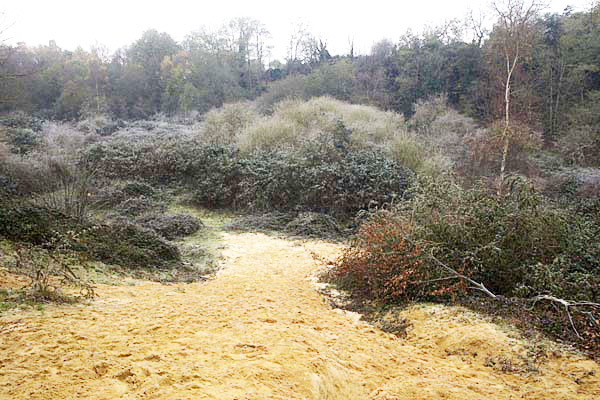

|
The demand for aggregates (sand, gravel, crushed rock) in the UK shows no sign of abating as more and more roads, homes and other man-made creations claimed to be necessary for the ultimate profit as well as improvement and fulfilment of society are constructed. For all the good intentions of the government-sponsored Aggregates Levy Sustainability Fund (ALSF) Partnership Grant Scheme, this extraction is placing ever greater pressure on the environment, often in areas which are vulnerable and possess significant biodiversity. Reigate Heath, a Site of Special Scientific Interest in Surrey, is just one example of a site which, until spring 2006, inexcusably was under threat from possible mineral extraction nearby. Focusing on sandpits, when they are in full flow their varied and in many instances warm micro-climates offer perfect opportunities for invertebrates and, occasionally, for such birds as Sand Martins (Riparia riparia). Once work in the pits is finished, though, it is all change - and rarely Of these, birds are seen as by far the most important, largely because of the overpowering influence their lobby has in the world of conservation and nature watching. If invertebrates - across the board, rather than just butterflies and dragonflies - had similar backing perhaps one or two disused sandpits might initially be left as they are, then managed to create a mosaic of habitats with sand dominant but with wet areas, woodland and controlled scrub also present. Benefits would accrue to a wide range of species, including mammals and birds as well as invertebrates. The fact is, in any planning of a reserve or natural area, the initial focus should always be on invertebrates and flora - everything else ought to follow as a matter of course. Happily the RSPB, taking the holistic view as always, is furthering the cause of a varied approach to mineral sites after extraction has ended. The website www.afterminerals.com provides a fascinating and inspiring insight into what the future may hold for the 1,300 active mineral sites in England. The small sandpit pictured on this page covers about two hectares and lies a stone's throw from Canon UK's headquarters in Reigate. Not used commercially for around 50 years, it is now owned by Reigate & Banstead Borough Council and to the end of 2009 it had not been managed effectively, if at all. Despite being almost entirely covered in scrub, the remaining parcel of open sand, no more than 5% of the total and probably less, was full of Hymenoptera each summer. Remarkably, the site has ten Red Data Book species plus 13 that are nationally scarce and was the first location in Surrey to host the bee Colletes hederae, Hymenoptera have peculiar and often subtle requirements, and the steady contraction of the open area at the sandpit, joined to general fragmentation in the wider area locally, was doing nothing to encourage the long-term survival of the habitat and its natural denizens. Early in 2010 the site was designated a Site of Nature Conservation Importance, with the promise of management to assist the invertebrates in particular. With the pit in increasing danger of complete scrub encroachment this was splendid news. Local volunteers visited five times between 2011 to 2013, opening up banks for nesting, but wet summers help encourage the growth of vegetation and towards the end of 2015 the site was in danger of becoming completely overrun by bracken, brambles, buddleia and broom. There is now much less open sand than in the pictures on this page. Fortunately there has been a reduction in the number of occasions when local youths dig the sand and turn sections of the locale into a cyclo-cross course and even light fires. A typically damaging piece of vandalism occurred in March 2007 when two large tyres were set fire to, making a significant portion of the open sand a temporary no-go area for fauna. A thing very much of the past one hopes. But in 2015 contractors for the owners sliced off a valuable piece of sandy bank containing a number of bee and wasp nests. Presumably this vandalism was the result of rank ignorance rather than malice. Either way, reports late in 2015 that a feasibility study was to be carried out with a view possibly to developing the southern third of the site with housing, and putting some of the cash gained into turning the remainder into a nature reserve, was not entirely encouraging. This opinion is based not only on the way the sandpit has been treated for the last half-century but also on the fact that its essential importance rests on there being bare and in places loose sand, a vulnerable habitat and not an easy one to turn into a nature reserve with paths and free access. A selection of the 100+ species of bee and wasp found in the pit is shown under the headings below. Images © Jeremy Early. All rights reserved. In 2013 I published My Side of the Fence - the Natural History of a Surrey Garden. Details may be found, and orders placed, via this hyperlink My Side of the Fence. In November 2015 Surrey Wildlife Trust published the atlas Soldierflies, their allies and Conopidae of Surrey, jointly written by David Baldock and me. Details are on this web page: Atlas. |